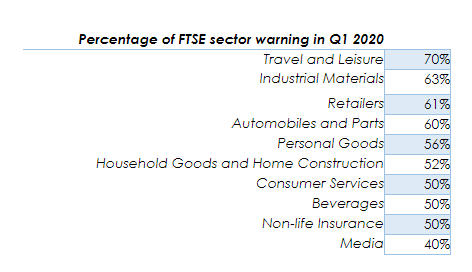
Record profit warnings – but what next?
14 July 2020
UK-quoted companies issued as many profit warnings in the first quarter of 2020 as we’d usually record in a year. The total of 301 warnings smashes all previous records, with 21% of companies warning in the first three months of 2020 compared with the previous high of 8% in Q4 2001, in the wake of 9/11. In fact, a higher percentage of quoted companies warned in Q1 2020 than the whole of 2008.
These numbers certainly make very stark reading – but the biggest challenge lies ahead, with the restart proving tougher for many companies than the lockdown.
No place to hide
Some sectors have clearly been harder than others by the impact of Covid-19. EY’s data shows that 70% of FTSE Travel & Leisure companies and 60% of FTSE Retailers issued profit warnings in the first quarter. These are truly astonishing numbers and it’s obviously the consumer discretionary part of the economy that’s been hit hardest and fastest by the lockdown. But, our data shows that the full impact on the economy is broad – and broadening.
We have recorded profit warnings from 39 of the 42 FTSE sectors we track. The impact of global measures to stem the spread of Covid-19 has spread through supply chain disruption, corporate cash conservation – including delayed rent payments and falling spending in advertising and recruitment – and the consequences of a dramatic fall in global economic activity, which has triggered falls in trade, transportation and the oil price. Falls in oil industry capex have significant ramifications for many industrial sectors, as we saw in 2014–16 and our last significant peak in warnings. Broad-based falls in economic activity are also generating increased profit warnings in financial sectors.
There is obvious danger in the depth of Covid-19’s impact on sectors like retail and travel. But there’s also danger in the breadth of impact that our data highlights. One of the big lessons we learnt from 2008 is that the economy has interconnections that we don’t always understand until a vital link is severed.
A difficult transition
What does this mean for the next stage and the move from lockdown to recovery? We know from previous crises that one of the biggest tests comes when weakened companies and stressed management teams need to reflate balance sheets, restock inventory, restart operations and depend on supply chains that have been similarly tested. There were more insolvencies in 2009 than 2008, with numbers barely falling until the middle of the decade.
This time the restart-challenge is considerably larger due to the depth and breadth of the impact of Covid-19. Government support has been more extensive this time and focused on trying to minimise the structural damage, but there is a limit to its capacity and duration. The challenge is also much bigger. A quarter of UK businesses stopped trading during lockdown, and these will need mobilise from a standing start with weakened balance sheets no certainty over what demand awaits them and how well other companies in their supply chains have held up.
Moreover, businesses will need to do all this while re-engaging staff and implementing social-distancing measures that could fundamentally test the feasibility of their business. Many businesses will not be profitable at lower capacity levels. Restarts will be particularly complex in businesses that cross national – and even sub-national borders – since the regulations and pace of recovery could differ and require very different approaches.
Managing cash and safeguarding business continuity and the health of employees and customers will be evolving and ongoing challenges as the regulations change. Getting the timing right on when and how to start up and invest will be crucial given the uncertainty of the outlook. Companies will need to maintain some flexibility in the event of a second wave.
The bigger picture
It’s also important to take a step back and think about what was happening last year. In 2019, profit warnings hit exceptional 2008-like levels, reflecting the high economic and structural stresses on the economy. By the end of January 2020, warning levels were up 43% year-on-year. Covid-19 has added new pressures, but in many ways these have exacerbated existing issues and accelerated prevailing trends.
Most of the sectors that were under significant structural pressure in 2019 – restaurants, retailers, airlines etc – are those where we’re seeing the most significant amount of restructuring activity. But, deep restructuring in one area often triggers significant reshaping in others, for example in real estate and airports. Delays in corporate discretionary spending will also have wide-ranging implications across several sectors reliant on business-to-business spending. There could also be significant variation even within sectors. For example, the difference in fortunes between food and drink companies that supply supermarkets and those whose main customers are restaurants and pubs.
Very few companies will be totally immune from the wider fall out and potential disruption. Transparent and open communication is vital between companies, their lenders and other stakeholders. Where possible, companies should do all they can to support their supply chains. Companies that can flex and adapt their products and supply lines to new customers and new priorities are likely to fair better. Not least because the drivers of sector reshaping will include new norms in societal priorities, with this shift in values creating permanent changes in behavioural and values.
We don’t know when life will return to normal – or what that normal will be. But I expect to see a renewed focus on corporate purpose, long-term value and the interconnectivity between business and society. We are all in this together.
This is an extended version of the article that first appeared in the Summer 2020 edition of R3’s RECOVERY magazine. EY will release their Q2 2020 profit warning analysis on 20 July.
Alan Hudson is UK&I Restructuring Leader at EY.
Kirsten Tompkins is Transaction Advisory Services Senior Manager at EY.



